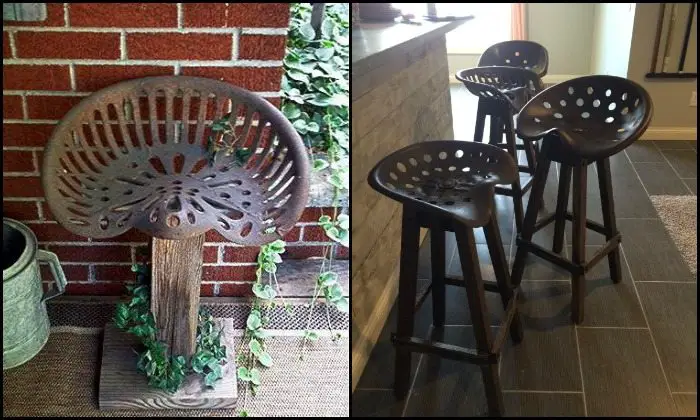
Baring it all takes a lot of courage, and modern industrial interior design is about exposing all that lies beneath to achieve a raw, unassuming but edgy style. A tractor seat bar stool is an example of this kind of furniture.
What other styles seek to conceal, the industrial theme boldly puts on display. The very structural elements of space become showpieces, achieving a look that seems unfinished, yet cohesive and chic.
Are you a fan of the industrial home design? Then here’s a furniture idea you’re going to like!
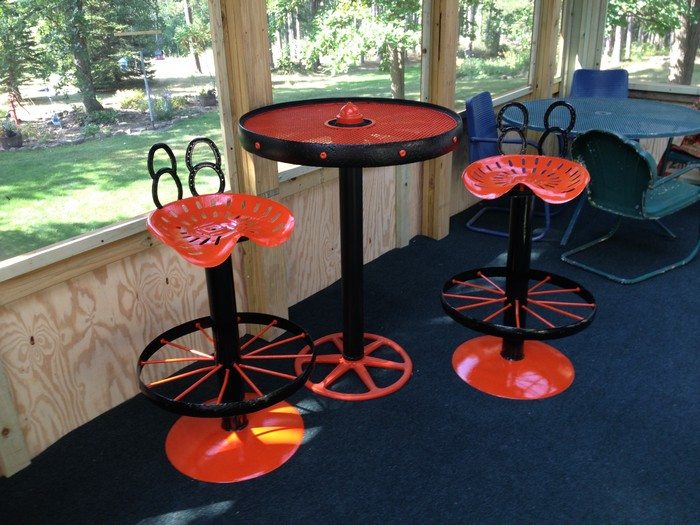
Yup, you guessed it – bar stools made from old tractor seats!
This furniture design makes an attractive feature for both inside and outside the house. You can use them as kitchen counter stools or as outdoor seating for the patio/backyard.
You can use any base that you desire, from old wheel rims, milk jugs, and other scrap metal to timber frames.
Paint them any way you like (with a rusty finish or bright colors), and they will surely be a conversation starter, regardless!
Got room for these stylish tractor seat bar stools in your home?
Contents
Building a Tractor Seat Bar Stool
Materials
- An old tractor seat
- A sturdy base (options include a metal pipe frame, an old wheel rim, or timber frame)
- Screws and bolts (appropriate size for your base and seat)
- Metal primer and paint (optional for a custom finish)
- Rubber feet (to protect floors)
- Wood (if using a timber frame) or metal rods (for a metal base)
Tools
- Drill with drill bits
- Screwdriver or electric screwdriver
- Wrench set
- Metal saw (if working with metal bases)
- Sandpaper or a metal grinder
- Paintbrushes (if painting)
- Measuring tape
Instructions
Prepare the Seat:
- Clean the tractor seat thoroughly to remove rust, dirt, and grime. Use sandpaper or a grinder for metal surfaces.
- Apply a coat of metal primer if you plan to paint it. Once dry, apply your chosen paint color. Allow it to dry completely.
Prepare the Base:
- Cut your metal rods or pipe to the desired height of your bar stool using a metal saw for a metal base. Ensure the base is sturdy enough to support weight.
- For a timber frame, cut your wood to the desired dimensions. Assemble the frame using screws and make sure it’s stable.
- If using a wheel rim, ensure it’s cleaned and painted if desired. It may need to be mounted on a flat metal or wooden plate for stability.
Attach the Seat to the Base:
- Position the tractor seat on the base. Use a measuring tape to ensure it is centered.
- Mark the drilling points through the holes in the tractor seat onto the base.
- Drill holes on these marks on the base for the screws or bolts.
- Secure the seat to the base using screws or bolts. Tighten them with a wrench or screwdriver.
Finishing Touches:
- If the stool feels unstable, consider adding additional supports between the legs of the base.
- For metal bases, you can weld for extra stability (optional and requires welding skills).
- Attach rubber feet to the bottom of the stool legs to protect floors and add stability.
Final Check and Customization:
- Inspect the stool to ensure all screws and bolts are tightly secured.
- Test the stool’s stability by sitting on it carefully. Make any necessary adjustments.
- Add additional finishes or decorations as desired, such as cushions for the seat.
Enjoy Your Tractor Seat Bar Stool:
- Place your new bar stool in its desired location, whether at your kitchen counter, workshop, or bar area.
The Role of Tractor Seat Bar Stools in Industrial Design
In industrial interior design, where authenticity and rawness stand at the forefront, tractor seat bar stools emerge as quintessential elements. These unique pieces serve as functional furniture and encapsulate the essence of industrial aesthetics. By embracing the rugged charm and historical context of their origin, tractor seat bar stools contribute significantly to industrial spaces’ thematic depth and visual appeal.
A Nod to Industrial Heritage
Tractor seat bar stools embody a rich narrative of industrial progress and ingenuity. Originally designed for use in the rugged world of agriculture, these seats have transcended their utilitarian origins to become symbols of industrial heritage in modern interior design. This transformation from practical farm equipment to stylish home décor items illustrates a profound respect for the craftsmanship and technological advancements of the past. By integrating tractor seat bar stools into contemporary spaces, designers and homeowners forge a tangible link to the industrial era.
These pieces serve not merely as functional seating but as historical artifacts that honor the legacy of hard work and mechanical innovation. The act of repurposing them reflects a deep appreciation for the resilience and creativity inherent in industrial design, seamlessly blending the practicality of yesterday with the aesthetic sensibilities of today.
Uniqueness and Character
The allure of each tractor seat bar stool lies in its distinctive appearance and storied past. No two stools are exactly alike, with variations in form and finish that speak to their individual journeys from the farm to the home. The wear marks and patina on each seat narrate tales of labor and endurance, adding depth and richness to the item’s character that cannot be replicated by mass-produced furniture. In spaces themed around industrial design, these stools contribute an element of authenticity and rough-hewn beauty that is highly prized.
Their unique shapes and designs—ranging from simple, ergonomic curves to intricate, cast-iron patterns—catch the eye and spark conversation, making them much more than mere places to sit. They are statements of style and history, blending seamlessly into the industrial aesthetic while standing out as pieces of art in their own right. In adding tractor seat bar stools to a room, one not only enhances its visual appeal but also infuses it with a sense of personality and intrigue that enriches the space immeasurably.
Versatility in Design
Despite their rustic origins, tractor seat bar stools are remarkably versatile. They can be mounted on various bases, from sleek metal frameworks to rustic wooden legs, allowing them to fit seamlessly into diverse industrial settings. This adaptability makes them ideal for both residential and commercial spaces, from kitchens and dining areas to bars and creative studios.
Functionality Meets Aesthetics
In industrial design, the balance between functionality and aesthetics is paramount. Tractor seat bar stools exemplify this principle by offering comfortable seating while serving as standalone art pieces. Their ergonomic design, originally intended for long work hours, translates well into modern usage, where comfort cannot be compromised.
Sustainability and Upcycling
Incorporating tractor seat bar stools into interior design aligns with the broader movement towards sustainability and upcycling. By repurposing old tractor seats, designers and homeowners are making an environmentally conscious choice. This practice reduces waste and adds a layer of story and authenticity to the furniture piece, further enriching the industrial theme.
Tractor seat bar stools play a pivotal role in industrial design by embodying the principles of authenticity, history, and innovation. Their unique appearance, coupled with their functional and sustainable appeal, makes them indispensable in creating spaces that are both visually compelling and deeply rooted in industrial heritage. As these stools continue to grace modern interiors, they carry the spirit of an era defined by hard work and ingenuity, perfectly encapsulated within the industrial design paradigm.
Click on any image to start lightbox display. Use your Esc key to close the lightbox. ![]()
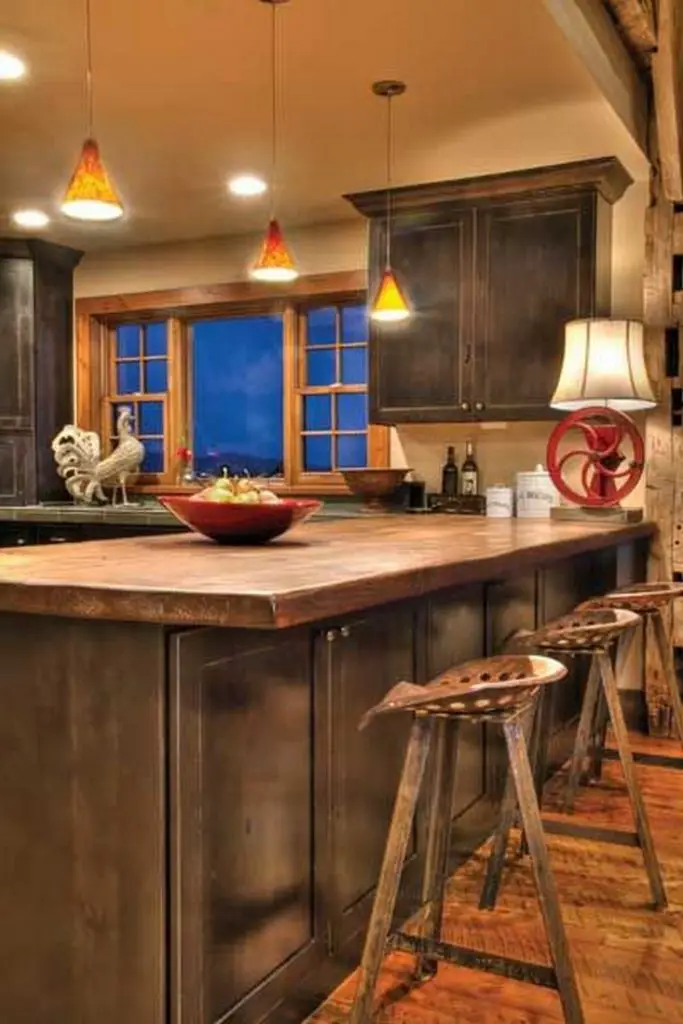

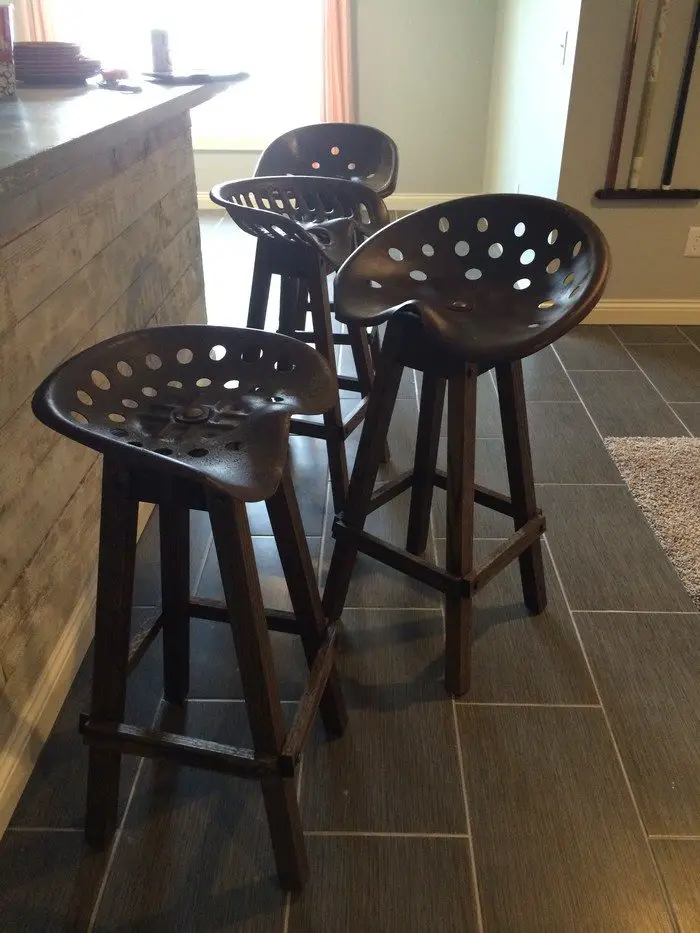

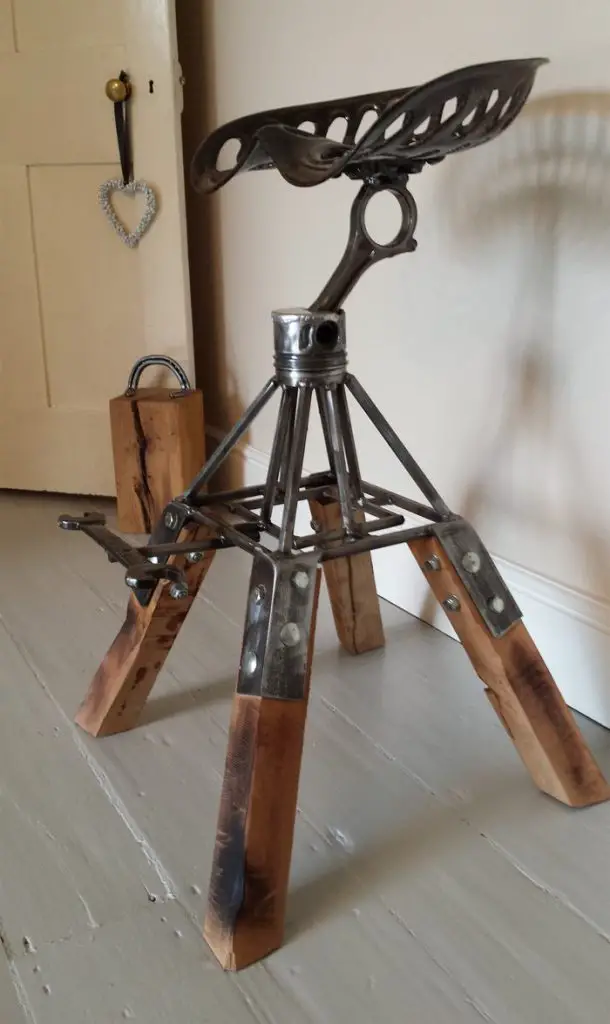

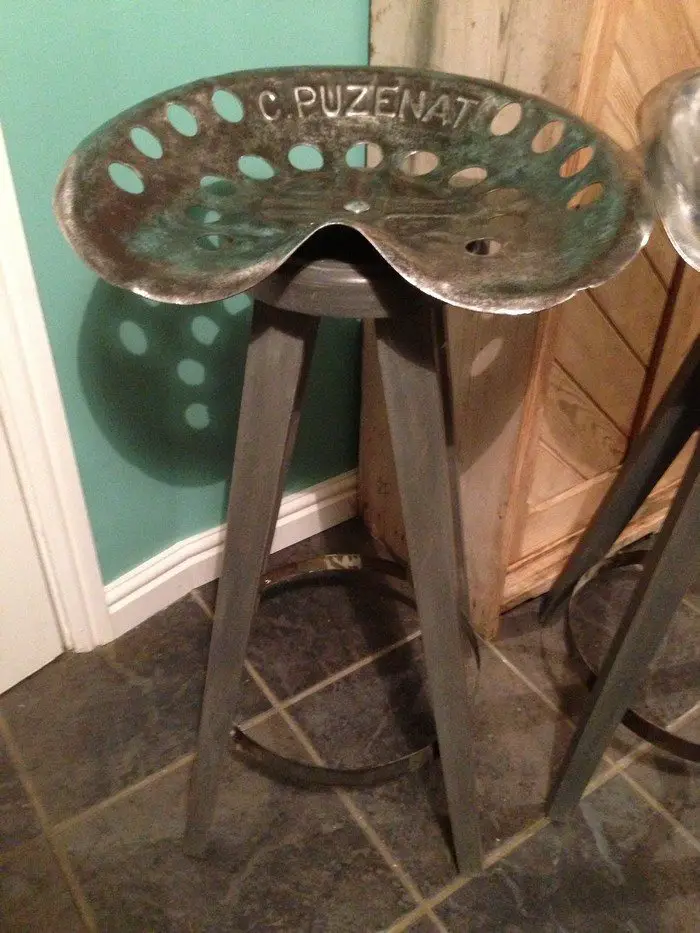
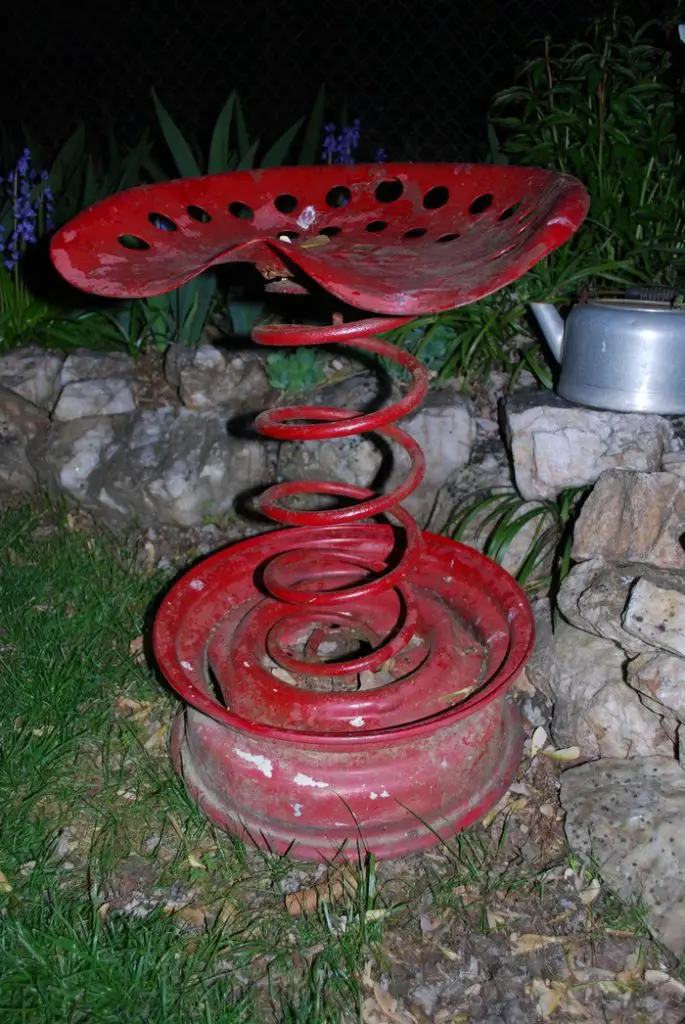
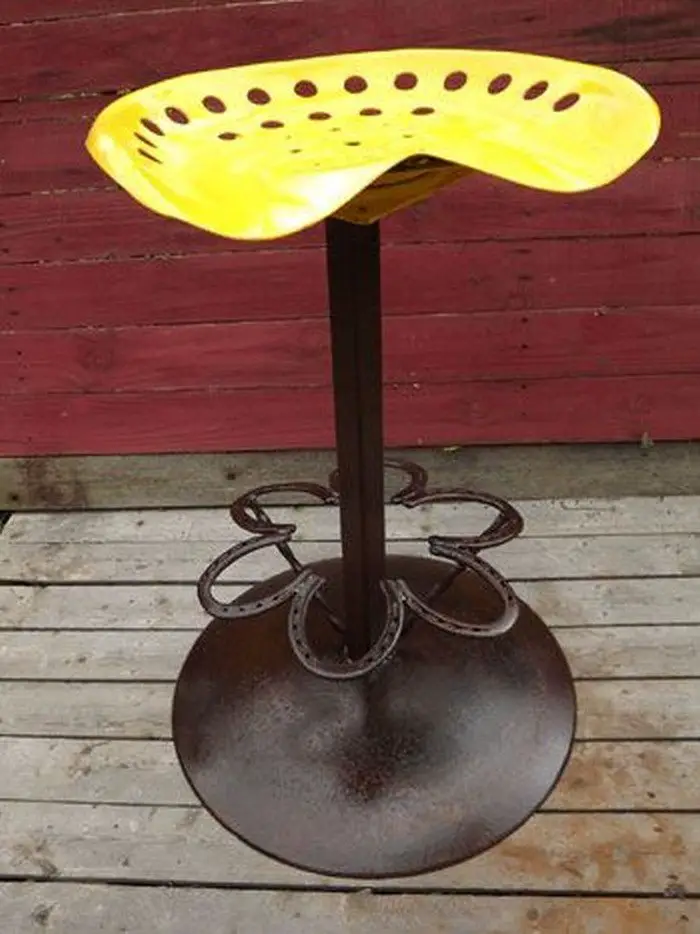
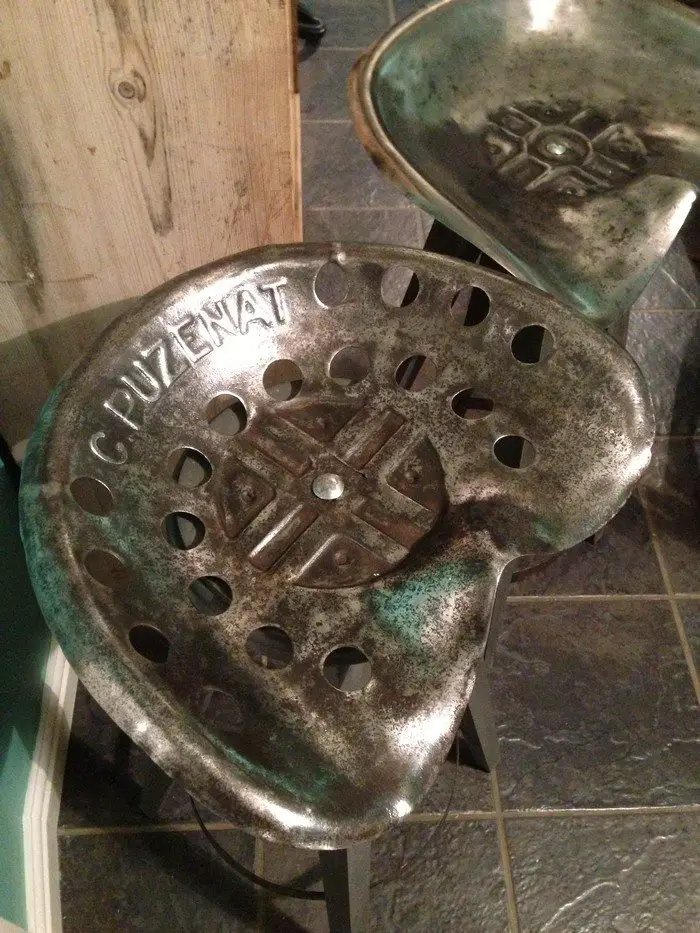
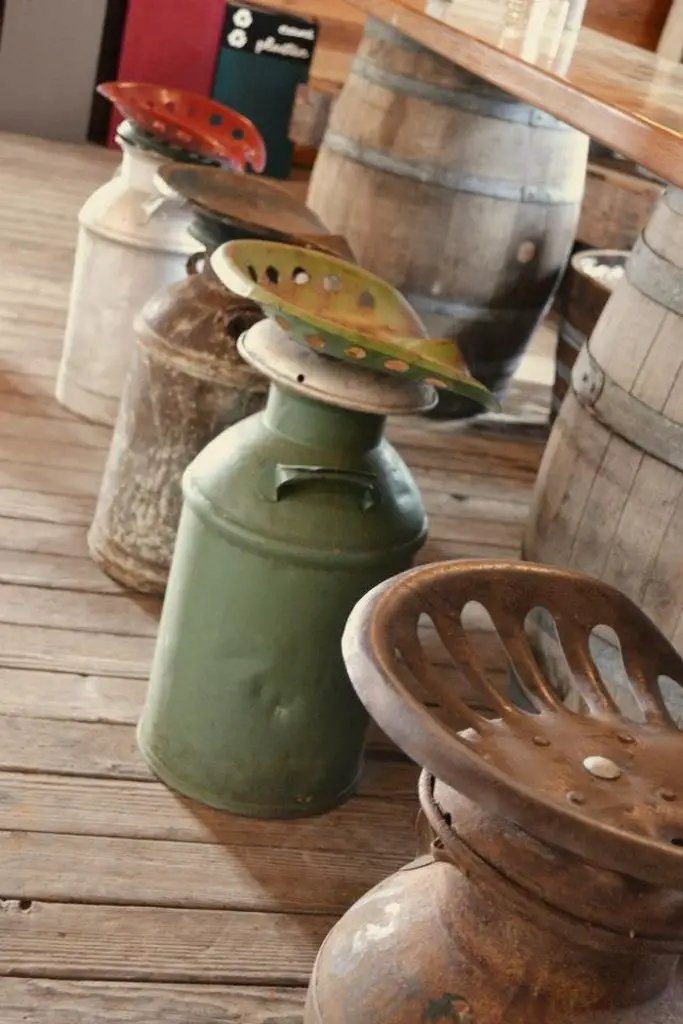
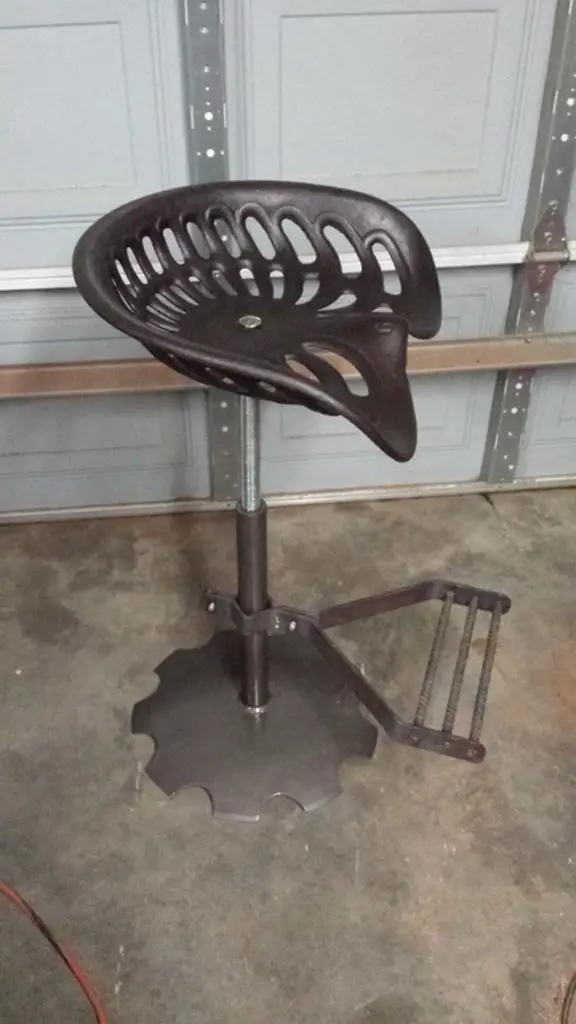
Maintenance and Care for Tractor Seat Bar Stools
Tractor seat bar stools not only stand out for their unique aesthetic appeal but also for their durability. However, like any cherished piece of furniture, they require proper maintenance and care to preserve their beauty and functionality over time.
Proper upkeep ensures these stools remain a vibrant part of your space, reflecting the industrial chic style with as much authenticity and character as the day you brought them home.
Regular Cleaning
- Dusting: Regularly dust your tractor seat bar stool to prevent buildup. Use a soft, dry cloth to wipe the surface gently.
- Washing: For deeper cleaning, use a mild soap and water solution. Wipe the surface with a soft cloth, paying extra attention to crevices where dust and grime may accumulate. Ensure to dry the stool thoroughly afterward to prevent rust, especially on metal parts.
- Non-abrasive Solutions: Opt for non-abrasive cleaners for metal tractor seat bar stools to avoid scratching the surface. A mixture of water and vinegar can serve as an effective natural cleaning solution that helps in maintaining the stool’s shine without causing damage.
- Microfiber Cloths: When cleaning, use gentle microfiber cloths on all types of surfaces. Microfiber is excellent for trapping dust and particles, reducing the risk of scratching the stool during routine cleans.
- Air Drying: After washing your tractor seat bar stool, if possible, allow it to air dry in a well-ventilated area. Air drying helps prevent moisture from lingering on the metal, which could lead to rust formation.
Rust Prevention and Treatment
- Preventive Coating: If your tractor seat bar stool is made of metal and prone to rust, consider applying a clear lacquer or protective coating annually. This acts as a barrier against moisture and air, two elements that contribute to rust.
- Rust Treatment: Should you spot rust, address it promptly. Use a wire brush or sandpaper to gently remove rust spots. Afterward, clean the area and apply a rust-inhibiting primer, followed by touch-up paint that matches the original color.
- Frequent Inspections: Increase the frequency of inspections for signs of rust, especially in crevices and joints of the tractor seat bar stool. Early detection makes treatment easier and prevents the rust from spreading.
- Moisture Control: Consider using dehumidifiers in the room where your tractor seat bar stools are located in humid environments. Reducing air moisture can significantly decrease the risk of rust.
- Protective Waxes: Beyond clear lacquer, applying a protective wax to metal parts of the tractor seat bar stool can offer an additional layer of rust prevention. Choose a wax product suitable for metal surfaces and apply it according to the manufacturer’s instructions for long-lasting protection.
- Silica Gel Packets: If you’re storing tractor seat bar stools in an enclosed space, place silica gel packets nearby. These packets absorb moisture from the air, protecting your stools from rust.
- Touch-Up Kits: Keep a touch-up kit on hand that includes matching paint, a small brush, and rust-inhibitor primer. Quick touch-ups on any scratches or chips keep your tractor seat bar stools looking good and prevent these minor damages from becoming rust initiation points.
Upholstery Care (If Applicable)
- Cleaning Fabric Seats: For stools with cushioned seats, vacuum the upholstery regularly to remove dust and debris. For stains, use an upholstery cleaner suitable for the fabric type, following the manufacturer’s instructions.
- Leather Maintenance: If your tractor seat bar stool features a leather seat, clean it with a damp cloth and mild soap. Apply a leather conditioner periodically to keep the material supple and prevent cracking.
- Spot Cleaning Immediately: When spills occur on the upholstered seat of your tractor seat bar stool, act quickly. Blot the spill with a clean, dry cloth to prevent the liquid from seeping into the fabric. Avoid rubbing, as this can push the spill deeper into the fabric.
- Fabric Protector: Apply a fabric protector to the upholstered part of your tractor seat bar stool. This will create a barrier against spills, making it easier to clean up accidents and prevent stains from forming.
- Sunlight Exposure: To prevent fading, try to position your tractor seat bar stools away from direct sunlight. If they must be placed in a sunny spot, consider using window treatments to diffuse the light and protect the fabric’s color and integrity.
Protecting the Base and Legs
- Floor Protection: Use felt pads under the stool legs to protect your floors from scratches. Regularly check and replace these pads as needed.
- Tightening Screws: Periodically check all screws and fastenings. Tighten any that may have become loose over time to ensure the stool’s stability and prevent damage.
- Regular Checks for Corrosion: For metal bases, periodically check for signs of corrosion, especially in environments with high humidity or salt exposure. Early detection and treatment can prevent further damage.
- Use of Rubber Caps: Consider fitting the legs of your tractor seat bar stools with rubber caps. These caps not only protect your floors but also add an extra layer of protection against moisture for the stool legs, reducing rust risk.
- Lubrication of Moving Parts: If your tractor seat bar stool features adjustable height or swivel mechanisms, ensure these parts are lubricated regularly. This prevents wear and tear from friction and protects against corrosion. Use a suitable lubricant for metal components, applying sparingly to avoid buildup and dust attraction.
- Balancing Checks: Periodically check that your tractor seat bar stools are balanced and stable. Uneven weight distribution can put unnecessary stress on certain parts of the stool, leading to wear and potential damage. Adjust the leg levelers if your stool is equipped with them or consider adding them if not.
Seasonal Adjustments
- Outdoor Use: If you use your tractor seat bar stools outdoors, consider bringing them inside during extreme weather conditions or cover them with a waterproof cover to protect against rain, snow, and intense sun.
- Temperature Fluctuations: Consider placing your tractor seat bar stools near heat sources like radiators or air conditioning vents. Extreme temperature fluctuations can cause materials to expand and contract, potentially damaging metal and upholstery. Aim for a stable, room-temperature environment.
- Humidity Control for Outdoor Use: For tractor seat bar stools used in outdoor settings, consider using covers that allow for air circulation to prevent condensation buildup, which can lead to rust on metal components. During very humid seasons, moving them indoors or into a covered area may be beneficial.
- UV Protective Coatings: If your tractor seat bar stools are exposed to sunlight indoors or outdoors, consider applying UV protective coatings to metal and upholstered surfaces. This can help prevent fading and degradation caused by UV rays.
Long-Term Storage
- Proper Storage: If you need to store your tractor seat bar stool for an extended period, clean it thoroughly and apply a protective coating if it’s made of metal. Store in a dry, cool place to prevent damage and cover it with a breathable cloth to protect against dust.
- Ventilated Coverings: When covering your tractor seat bar stools for storage, use breathable fabric covers. Plastic coverings can trap moisture, leading to mold and mildew on upholstery and rust on metal parts. Breathable covers will protect from dust while preventing moisture accumulation.
- Elevate from the Floor: If storing in a garage, basement, or storage unit, elevate your tractor seat bar stools off the floor. This protects them from potential water damage, pests, and cooler temperatures that can cause condensation. Pallets or shelving units can be used for elevation.
- Desiccants for Moisture Control: Place desiccant packets or containers within the storage area to absorb excess moisture. This is particularly useful in humid climates or during damp seasons, protecting the metal and fabric components of your tractor seat bar stools from moisture-related damage.
- Check Periodically: Even in storage, it’s wise to periodically check on your tractor seat bar stools. This allows you to catch any potential issues early, such as signs of rust or pests, and take corrective action before significant damage occurs.
Maintaining your tractor seat bar stools with these care tips will ensure they add a touch of industrial charm to your space for years to come. Regular maintenance preserves the stool’s aesthetic appeal and its structural integrity, making it a worthwhile endeavor for any owner of this distinctive furniture piece.
Conclusion
Crafting tractor seat bar stools is an innovative way to merge style with history, offering a unique and sustainable approach to home or commercial décor. These stools not only pay homage to industrial heritage but also provide a distinctive character to any space, blending functionality with unparalleled aesthetic appeal. The process encourages creativity and environmental consciousness, making tractor seat bar stools a compelling choice for those looking to infuse their interiors with personality and charm.
For more bar ideas, check out our post on outdoor kitchen bar design!






